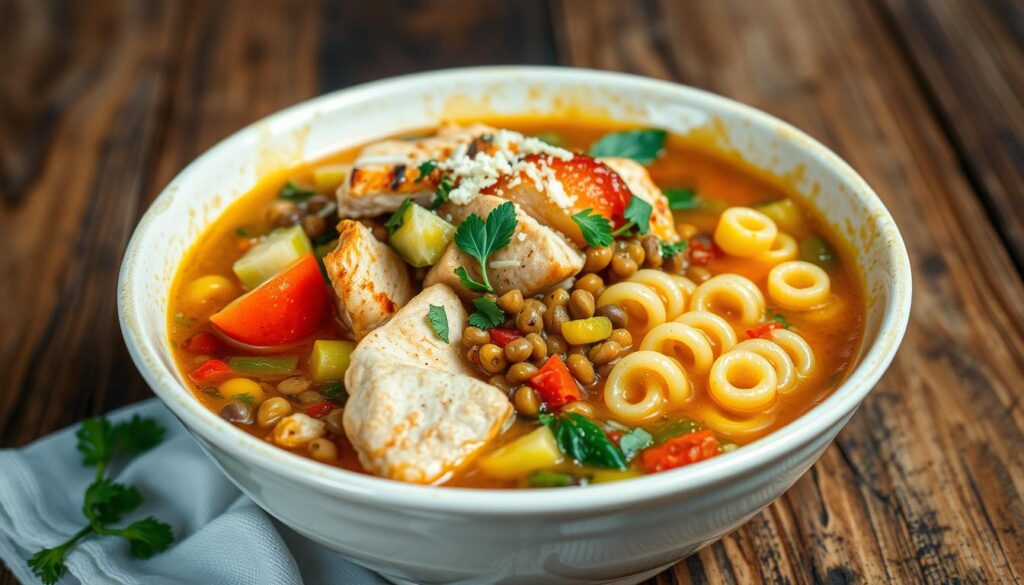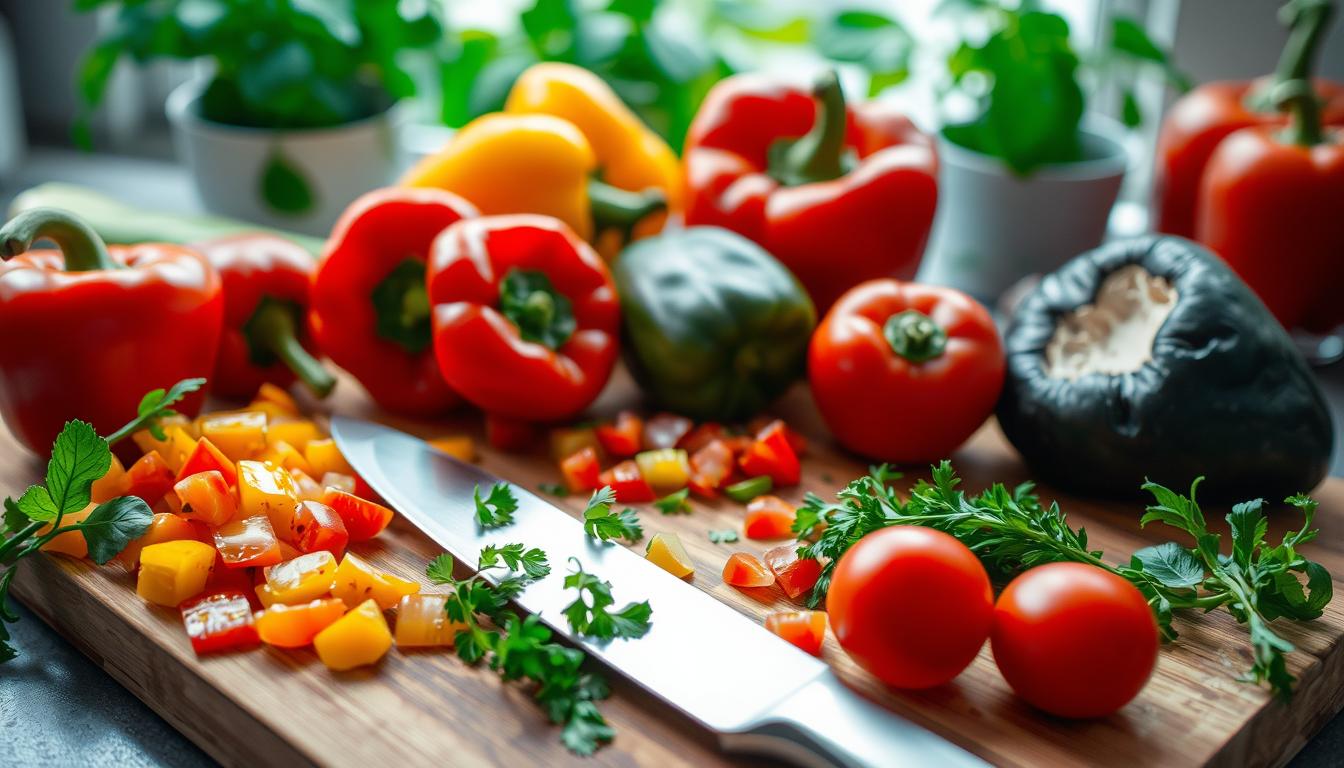Table of Contents
Making Vegetable Soup :
As the cool autumn breeze whispers against the window, I’m instantly transported back to the cozy kitchen of my childhood. The comforting aroma of homemade vegetable soup would fill the air. These memories remind me of the joy and connection found in making a wholesome meal.
Today, I’m excited to share an easy guide to making your own vegetable soup. This recipe is for everyone, whether you’re a seasoned cook or a beginner. It lets you use fresh, seasonal produce to make a dish that nourishes your body and spirit.
Homemade vegetable soup is not only delicious but also nutritious. By making your own, you control the quality of the ingredients. Each spoonful is full of vitamins, minerals, and antioxidants your body needs. Let’s explore how to make the perfect vegetable soup for your home.
Why Homemade Vegetable Soup Is Better Than Store-Bought
You can’t go wrong with homemade vegetable soup when it comes to taste and nutrition. By selecting the freshest ingredients, you have complete control over the sodium content. In this way, you can tailor the soup to your personal taste.
Homemade soup tastes better because you use fresh veggies. This gives your soup a natural, vibrant flavor. Store-bought soups often have less flavor and more sodium or preservatives.
Homemade soup is also healthier. Store-bought soups can have up to 800 milligrams of sodium per serving. Making your own soup lets you control the sodium. This makes your meal more nutritious and balanced.
Homemade soup lets you get creative. You can mix different veggies, adjust the thickness, and add your favorite spices. This personal touch is hard to find in store-bought soups.
Lastly, making your own soup is affordable and fun. The ingredients are cheap, and cooking the soup is relaxing. Homemade soup is cheaper than canned or pre-packaged options. It’s a cost-effective way to enjoy a nutritious meal.
In summary, homemade vegetable soup wins over store-bought in many ways. It tastes better, is healthier, and lets you customize it. By making your own soup, you get a delicious, nutritious meal that fits your taste and needs.
Essential Ingredients for the Perfect Vegetable Soup
Making a tasty vegetable soup begins with picking the right ingredients. You need fresh veggies and herbs. The broth and seasonings you choose can make the soup even better. Let’s look at what makes the perfect vegetable soup.
Fresh Vegetables and Aromatics
Using fresh vegetables is the key to a delicious vegetable soup. Crucial ingredients include peas, corn, celery, carrots, potatoes, and green beans. The taste and consistency of the soup are imparted by these veggies.
Garlic and herbs are also important. Fresh or dried thyme, rosemary, and parsley add a nice aroma to the soup.
Broth and Seasoning Options
The broth you choose is crucial for the soup’s taste. Use a homemade or store-bought broth that’s full of flavor. Adding tomato paste, canned diced tomatoes, or a bit of seasoning like Worcestershire sauce can enhance it.
The secret ingredient is seasoning. To give it more depth, you can add spices like red pepper flakes, bay leaves, and fennel seeds. Season with salt and pepper to taste.
Additional Flavor Enhancers
Adding ingredients like garbanzo beans (chickpeas) or frozen okra can make the soup even better. Beans add protein and fiber, while okra gives a unique texture and a bit of tanginess.
The perfect vegetable soup combines fresh veggies, savory broth, and the right seasonings. Focus on these elements to make a comforting and tasty soup that’s good for you.
Making Vegetable Soup: Step-by-Step Instructions
Making a tasty homemade vegetable soup is simple. Follow this guide to make a nourishing and flavorful soup at home.
- Begin by sautéing the aromatic vegetables. In a big pot or Dutch oven, heat some olive oil over medium heat. Add diced onions, carrots, and celery. Cook for 5-7 minutes, stirring now and then, until they’re soft.
- Next, combine the tomato paste and garlic. Combine the vegetables with minced or pressed garlic, around two or three cloves. Once the aroma begins to fill the air, cook for one more minute. Flavor it up by stirring in a tablespoon or two of tomato paste.
- Add the broth at this point. Broth made from chicken, beef, or vegetables is at your disposal. Let it simmer gradually.
- Add the rest of the vegetables. Put in diced potatoes, green beans, corn, and other seasonal veggies you like. Let it simmer for 20-25 minutes, until the veggies are tender.
- In the last few minutes, add frozen peas. They’ll add color and freshness to your soup.
- Add some herbs and a touch of acidity to finish. Remove the saucepan from the heat and stir in the chopped fresh herbs, such as oregano, thyme, or parsley. For a more vibrant taste, try adding a little vinegar or lemon juice.
And that’s it—a delicious, step-by-step guide for a hearty, home-cooked vegetable soup. Adjust the seasonings to your liking, and enjoy this comforting and nutritious meal.
Choosing and Preparing Your Vegetables
Creating a delicious homemade vegetable soup starts with picking the right ingredients. Choose a variety of seasonal vegetables for the best taste and nutrition. Use everything from crunchy carrots and celery to potatoes and tender greens. Each one adds something special to your soup.
Proper Chopping Techniques
Start by chopping your ingredients into small pieces. It’s important to chop them all the same size for even cooking. Cut harder veggies like carrots and potatoes into smaller bits than softer ones like zucchini or spinach. This way, your soup will have a perfect mix of textures and tastes.
Seasonal Vegetable Selection
- Use the season’s best seasonal vegetables in your soup. It makes the flavor better and adds more nutrients.
- Think about adding sweet potatoes, green beans, butternut squash, or Brussels sprouts, depending on the season.
- Try different mixes to find your favorite vegetable combination.
Size and Cut Consistency Tips
It’s important to chop your veggies the same size. This ensures they cook evenly, making your soup smooth. Remember, cut harder veggies like carrots and potatoes into smaller pieces than softer ones. This balance is key to a great soup.
By chopping your ingredients right and choosing seasonal vegetables, you’ll make a soup that’s both tasty and healthy. It’s sure to please your taste buds.
The Art of Building Flavor Through Sautéing
Creating a delicious homemade vegetable soup starts with sautéing aromatics. Onions, carrots, and celery cooked in olive oil bring out amazing flavors. This method, called “sweating,” makes the vegetables taste sweeter and blends their flavors together.
But that’s not all. Toss in the tomato paste and seasonings once the veggies have turned a golden color. By adding this step, the soup’s flavor becomes even more robust and nuanced. In terms of flavor, it’s revolutionary.
The secret to great sautéing aromatics and flavor development is in the technique. Cook the vegetables over medium heat, stirring often, until they’re soft and caramelized. This caramelization brings out a depth of flavor that’s unmatched. Your soup will be a symphony of tastes, with each note perfectly balanced.
| Ingredient | Quantity |
|---|---|
| Garlic | 8-10 cloves |
| Fresh cream | 3 tablespoons |
| Butter | 1 tablespoon |
| Oil for base preparation | 1 tablespoon |
| Water | As required |
| Sugar | 1 tablespoon |
By mastering the art of sautéing aromatics, your homemade vegetable soup will be unforgettable. Get ready to amaze your taste buds and impress everyone with your cooking skills!
Broth Selection and Preparation Tips
The broth is key in vegetable soup, setting the stage for flavors. You can choose homemade or store-bought, but there are important things to remember.
Homemade vs. Store-Bought Broth
The most optimal option is to make your own vegetable broth. You may customize the taste by selecting the elements. But, not everyone can make their own. If that’s you, look for low-sodium vegetable broth at the store. These broths are easy to use and can be a good base for your soup.
Adjusting Broth Seasoning
Whether you use homemade stock or store-bought, season it to taste. Start by tasting the broth alone, then add salt and black pepper. You can also add dried herbs like thyme or rosemary to boost the flavor. For a tangy touch, a bit of vinegar or lemon juice works well.
| Broth Type | Advantages | Considerations |
|---|---|---|
| Homemade Vegetable Broth |
|
|
| Store-Bought Low-Sodium Broth |
|
|
Perfect Cooking Times and Temperatures
Knowing the correct simmering periods and temperatures is essential for making the best soup. Get the soup started by boiling it over medium-high heat. Turn the heat down to low and simmer gently once it boils.
This gentle simmer is key. It helps the flavors mix well and the vegetables to cook just right. They should be tender but still keep their texture and nutrients.
The best simmering time for your homemade vegetable soup is 20-25 minutes. This time makes sure the vegetables are cooked but not too soft. Quick ingredients like peas or leafy greens should be added in the last 5-10 minutes. This keeps their fresh taste and texture.
| Cooking Step | Recommended Time |
|---|---|
| Bring soup to a boil | 5-7 minutes |
| Reduce heat to simmer | 20-25 minutes |
| Add quick-cooking vegetables | 5-10 minutes |
If you prefer using a slow cooker, you can make delicious vegetable soup. Just cook it on low for 4-5 hours. Remember to add quick ingredients like peas or spinach in the last 20 minutes. This keeps their texture and flavor.
The secret to perfect simmering soup is keeping the temperature gentle and steady. This lets the ingredients fully develop their flavors without overcooking the vegetables. By following these tips, you’ll always make a tasty and healthy vegetable soup.
Customizing Your Soup with Additional Ingredients
Making your own vegetable soup is fun because you can change it up. You can add things to make it taste better and be healthier. Think about adding some extra ingredients to make your soup special.
Protein Options
Want a soup that’s more filling? Add some protein to it. Here are some good choices:
- Beans – Like chickpeas, kidney beans, or lentils, for more fiber and protein.
- Cooked Chicken – Shredded or diced, for a lean protein source.
These protein additions will make your soup more filling and nutritious.
Grain and Pasta Additions
Want a bigger meal? Add some small pasta shapes or grains to your soup. Try adding orzo or ditalini pasta 10 minutes before it’s done. Or, add cooked quinoa, brown rice, or barley for more fiber and whole grains.
Try different combinations to find your favorite soup. You can make your vegetable soup just the way you like it.

Storage and Reheating Guidelines
Enjoy your homemade vegetable soup while learning how to store and reheat it. The right methods keep the soup fresh, flavorful, and nutritious.
Storing Vegetable Soup
Once cooled, put the soup in airtight containers and refrigerate. It stays good for 4-5 days. For longer storage, freeze it. Use freezer-safe containers or bags for up to 3 months.
Reheating Vegetable Soup
- The night before you plan to reheat frozen soup is the best time to let it thaw.
- Warm it gently on the stovetop, stirring often, until hot.
- Or, reheat in the microwave in 1-minute intervals, stirring between each.
- For creamy soups, use low heat and stir often to avoid separation.
- Broth-based soups might need more broth if it evaporates. Add water to chunky soups to keep the right consistency.
- Add fresh ingredients like pasta or herbs just before reheating to keep them fresh.
Follow these tips for the best taste and texture, whether it’s fresh or reheated.
| Soup Storage | Refrigerator | Freezer |
|---|---|---|
| Shelf Life | 4-5 days | Up to 3 months |
| Reheating Method | Stovetop or microwave | Thaw in refrigerator, then reheat |
| Reheating Tips |
|
|
Nutritional Benefits and Dietary Considerations
Homemade vegetable soup is not only tasty but also very healthy. It has about 137 calories per cup. It also has a good mix of fat, carbs, and protein.
Vitamins A and C abound in this soup. It meets 83% of your caloric needs and 34% of your protein needs. Additionally, it is beneficial to your health due to its high potassium content. In addition, it has 8 grams of fiber, which aids digestion.
One of the best things about making your own vegetable soup is you can change it to fit your diet. You can make it vegan or low in sodium. This way, you can enjoy a healthy meal that meets your health goals.
| Nutrient | Amount per Serving | % Daily Value |
|---|---|---|
| Calories | 137 | – |
| Fat | 5.7g | – |
| Carbohydrates | 20.3g | – |
| Protein | 3.2g | – |
| Vitamin A | 4134IU | 83% |
| Vitamin C | 30mg | 34% |
| Folate | 52mcg | 13% |
| Sodium | 406mg | 18% |
| Calcium | 106mg | 8% |
| Iron | 3mg | 17% |
| Magnesium | 89mg | 21% |
| Potassium | 866mg | 18% |
Adding this healthy meal to your diet can boost your veggie intake and hydration. It also helps with weight management. Plus, it meets your dietary needs and preferences.
Serving Suggestions and Pairings
Make your homemade vegetable soup even better with different serving ideas and pairings. The soup is the main attraction, but sides can make the meal even more enjoyable. They can also satisfy your taste buds.
Crusty bread, like sourdough or dinner rolls, is a classic choice. It’s great for dipping into the soup’s flavorful broth. You can also serve the soup in a sourdough bread bowl for a fun twist.
Adding fresh herbs, sour cream, or cheese on top can make a big difference. These simple touches can enhance the soup’s flavors and textures.
Pairing your soup with a light salad or half sandwich can make it a more filling meal. Vegetable soup is versatile and can be enjoyed on its own or with other dishes.
Try out different soup pairings and serving ideas to find new favorites. Whether you prefer comforting carbs or crisp sides, there are endless ways to enjoy your soup.
To make the best vegetable soup, you need to pay attention to the presentation, flavors, and textures. It’s okay to experiment and be creative when cooking.
Conclusion
Making homemade vegetable soup is easy and rewarding. It lets you create a meal that’s both tasty and healthy. You can use different vegetables, herbs, and spices to make it your own.
This guide will help you make a soup that’s better than store-bought. You can choose between a hearty roasted soup or a light broth. It’s a great way to start making your own special soup.
With a bit of practice, you’ll make delicious soup that’s good for you. Enjoy cooking and be creative. Make a soup that you and your family will love to eat again and again.

